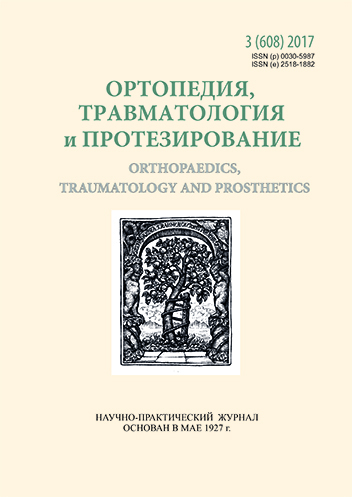Mineral density of bone tissue in women with arthrosis of various locations
DOI:
https://doi.org/10.15674/0030-59872017363-67Keywords:
osteoporosis, gonarthrosis, coxarthrosis, spondyloarthrosis, bone mineral density, t-criterionAbstract
Arthrosis and osteoporosis — common diseases of the musculoskeletal system in the elderly, precocious and senile age, which predetermines the study of their general pathogenetic mechanisms of development.
Objective: to study the bone mineral density in women with various clinical forms of arthrosis.
Methods: bone mineral density was analyzed in 282 patients over 56 years of age with gonarthrosis, coxarthrosis and spondyloarthrosis. The examined groups of patients did not differ by body mass index and age. The bone mineral density study was performed on the bone densitometer «Explorer QDR W» (Hologic) in the lumbar spine, proximal femoral area, with an additional assessment of the femoral neck or distal posterior part of the forearm. The diagnosis of «osteopenia» or «osteoporosis» was established in accordance with WHO recommendations fand using t-criterion. Digital figures were statistically calculated using the Excel 2003 program.
Results: after analyzing the densitometric measurements of bone mineral density in patients with various clinical forms of arthrosis, the lowest rates were observed in women with coxarthrosis (80.4 %) and spondylarthrosis (71.4 %). In patients with gonarthrosis, bone mineral density rates were reduced by 57.2 %. Osteoporosis was found in 26.1 % of women with gonorrhea, 25.5 % with coxarthrosis, and 38.4 % with spondylarthrosis. Significant decrease in bone mineral density was found in the axial part of the skeleton (lumbar spine and femoral neck) in patients with coxarthrosis and gonarthrosis compared to the forearm bones (p < 0.05). In the case of spondylarthrosis, the decrease in bone mineral density is recorded both in the axial and in the peripheral parts of the skeleton.
Conclusions: women with different clinical forms of osteoarthritis have low bone mineral density with a prevalence of osteopenia. The obtained data testify to the need for further study of the common pathogenetic mechanisms for the development of reduction of bone mineral density and arthrosis.Downloads
How to Cite
Issue
Section
License
Copyright (c) 2017 Mykola Korzh, Natalia Yakovenchuk

This work is licensed under a Creative Commons Attribution 4.0 International License.
The authors retain the right of authorship of their manuscript and pass the journal the right of the first publication of this article, which automatically become available from the date of publication under the terms of Creative Commons Attribution License, which allows others to freely distribute the published manuscript with mandatory linking to authors of the original research and the first publication of this one in this journal.
Authors have the right to enter into a separate supplemental agreement on the additional non-exclusive distribution of manuscript in the form in which it was published by the journal (i.e. to put work in electronic storage of an institution or publish as a part of the book) while maintaining the reference to the first publication of the manuscript in this journal.
The editorial policy of the journal allows authors and encourages manuscript accommodation online (i.e. in storage of an institution or on the personal websites) as before submission of the manuscript to the editorial office, and during its editorial processing because it contributes to productive scientific discussion and positively affects the efficiency and dynamics of the published manuscript citation (see The Effect of Open Access).














